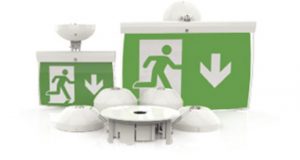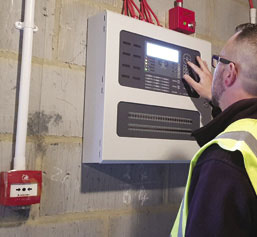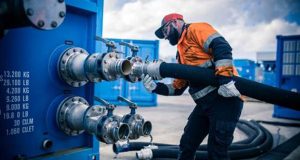Caroline Judd, Director, Turnkey Fire Services looks at the basics required when carrying out a Fire Risk Assessment (FRA) and the range of fire detection and warning systems available to help protect your premises
A fire risk assessment covers all the essential aspects of fire safety and will identify the fire hazards within a building, determining how a fire could start and spread, and the people who would be put at risk if there was a fire. It will allow you to consider how these risks can be reduced or eliminated, and how the building would be evacuated in the event of an emergency. There are a number of key areas to include in your assessment.
MEANS OF ESCAPE
 Everyone in your premises should be able to escape to a place of ultimate safety in a reasonable time. The suitability of the means of escape is crucial to the safety of the building’s occupants.
Everyone in your premises should be able to escape to a place of ultimate safety in a reasonable time. The suitability of the means of escape is crucial to the safety of the building’s occupants.
EMERGENCY LIGHTING
Adequate lighting helps occupants reach a place of safety in the event of power failure during a fire. Emergency lighting is also required to illuminate the means of raising the alarm and any fire-fighting equipment.
FIRE DETECTION AND WARNING
The extent of a fire detection and warning system will depend on the nature and use of your premises. If a fire could develop undetected then a fire alarm system is required. One of the key elements of your FRA will be considering how a fire in your building would be identified and the alarm raised. For most buildings this will mean having a suitable fire alarm system, with automatic smoke detection and sounders to alert all building users in the event of fire. You must ensure that everyone in your building can raise an alert and hear the alarm no matter where they are in the building, giving special consideration to those with physical needs such as hearing impairment or mobility  issues. Detection should be fitted to give the earliest possible warning of fire, particularly in areas where there is a high risk of fire starting or spreading unnoticed.
issues. Detection should be fitted to give the earliest possible warning of fire, particularly in areas where there is a high risk of fire starting or spreading unnoticed.
FIRE HAZARDS
For a fire to start, three things are needed: a source of ignition, fuel and oxygen. If any one of these are missing, a fire cannot start. These are more likely to occur in manufacturing sites but if you can avoid these occurring together it will reduce the chances of a fire occurring.
FIRE-FIGHTING EQUIPMENT
Firefighting equipment can reduce the risk of a small fire – such as a fire in a wastepaper bin – developing into a large one. The amount and type of portable extinguishers on your premises must be suitable for the risk.
MANAGEMENT
Good management of fire safety in your premises is essential to ensure that any fire safety matters that arise are always effectively addressed. It is also your responsibility to ensure that everyone within your organisation, including any visitors, understand their responsibilities. Clear instructions should be provided to all members of staff and visitors (including contractors working on site) regarding the emergency plan and any controls required such as permits for hot work. This should be relevant and easily understood, and should consider any shift patterns, language, and learning difficulties.
 Depending on the size of your business and building type you may need to appoint colleagues to specific roles such as Fire Warden or Fire Marshal. As the Responsible Person it is your responsibility to ensure that anyone with a defined role has relevant training so that they clearly understand what their responsibilities are. You may also want to consider training for the use of portable extinguishers and other firefighting equipment on site.
Depending on the size of your business and building type you may need to appoint colleagues to specific roles such as Fire Warden or Fire Marshal. As the Responsible Person it is your responsibility to ensure that anyone with a defined role has relevant training so that they clearly understand what their responsibilities are. You may also want to consider training for the use of portable extinguishers and other firefighting equipment on site.
Finally, you should ensure that your emergency plan is tested with a fire drill on a regular basis. Fire safety will require regular on-going management, to ensure fire exits remain clear and that combustible materials are safely stored.
PERSONS AT RISK
As part of your fire risk assessment, you need to identify those at risk if there is a fire. Persons requiring assistance to evacuate will need to be appropriately considered and catered for.
SIGNS AND NOTICES
Signs must be used, where necessary, to help people identify escape routes, find firefighting equipment and emergency fire telephones.
COMPARTMENTATION
How a building has been constructed plays a key part in protecting the means of escape and preventing unseen spread of fire within the premises. Take a good look at your building, how it is constructed and how it is used.
WHAT NEXT?
Once the FRA has been prepared and recorded you will be able to identify the points where action is required. These should be prioritised, and each given a target completion date. These actions may include providing your staff with training, installing fire safety equipment such as fire extinguishers and signage, and conducting regular fire drills.
The FRA shouldn’t just be consigned to a dusty shelf once it is complete. It requires regular review and update to keep the document ‘live’. Some certified Fire Risk Assessors will provide an online document, making it easier to post updates as each item on your checklist is actioned.
So, you’ve met all your obligations and achieved compliance for your business, how do you ensure you stay compliant?
Like an MOT for a car, regular maintenance is essential to ensure your fire safety systems remain fit for purpose. As an employer you have a legal responsibility to ensure that maintenance is carried out correctly. This can be assured by choosing a company that has achieved third party certification such as the BAFE SP203 Scheme or BRE LPS 1014. Certified companies are subject to regular third-party audit to ensure they meet the required technical and quality standards, and their staff are competent.
As well as the routine maintenance, your FRA will promote weekly fire alarm system tests. This check of the system is made by testing a different manual call point each week to make sure that the alarms sound. If you don’t feel confident to complete this check yourself, you should ask your fire alarm maintenance provider for training or alternatively add the weekly tests to their maintenance regime.
(i) www.bafe.org.uk/bafe-fire-safety-services
(ii) www.bafe.org.uk/become-bafe-registered/bafe-sp201-registration-process




